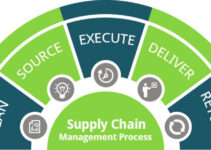The retail industry is the world’s most dominating business industry. It bridges the gap between customers and manufacturers by offering them all the required goods and services to satisfy their needs. On the hand, SCM manages the flow of products and goods from suppliers to the end consumers. Today, we’ll discuss retail supply chain management; how to improve it, its advantages and disadvantages, and future trends.
The SCM comprises of following processes and areas;
- Procurement and purchasing
- Logistics
- Warehousing and inventory management
- Delivering finished goods to retailers & wholesalers
What is Retail Supply Chain Management?
The retail industry faces a lot of pressure on maintaining pace with the latest new product items, stock, and trends; delivering final products efficiently and on time. In order to satisfy the needs and wishes of customers, retailers streamline their SCM processes and operations to make sure smooth movement of goods and products from suppliers to customers.
When it comes to delivering final products to the ends customers, the supply chain processes in the retail sector comprise of following areas;
- Sourcing and finding
- Procurement
- Manufacturing & production
- Warehousing & Inventory
- Transportation
- Customer management
Retailers could amplify their responsiveness and efficiency by optimizing various areas of the supply chain and decreasing costs. Inventory management is the key area in the SCM processes; the retailers need to maintain a perfect balance between too low or too high stock. However, it is a great challenge for them to main stock in different. For instance, the demand for clothes is very high in the winter than in the summer.
How to Improve Retail SCM
Some of the main ways how to improve retail supply chain management are as follows;
Integrating Retail System
Businesses and companies face a lot of challenges relevant to SC processes, and those issues need solutions. A good SC system manages various areas ranging from the production and manufacturing of finished goods to the end consumers. In fact, the success of your SC processes and operations relies on integrating your retail system. It requires you to integrate various areas, bring them on the same page, and communicate with them following;
- Carriers
- Customers
- Wholesalers
- Distributors
- Producers
- Planner
When various parties collaborate with each other, then it reduces costs and errors. The automation technology would help you to connect and combine various areas like;
- E-commerce
- CRM
- Accounting
- Inventory management
- POS (point of sale)
Reverse Logistics Accounts
Reverse logistics is an SCM strategy that consists of flowing goods backward from customers to retailers and producers. Recycling and returning damaged goods need reverse logistic practice. However, it comprises of following areas;
- Returned labels
- Analyzing returned labels
- Processing refunds
- Shipping damaged goods for an exchange
The objective of reverse logistics is to dispose of or regain value from the product. Returns aren’t good for the business; roundabout 95% of the customers say that a poor return experience would push customers away from buying it again from the brand.
Accurate Forecasting
Demand forecasting would allow you to predict the future demanded products and goods that the customers would buy. It helps you to decide the following;
- Product offering
- Inventory
- Decreasing stockout
- Maintaining cash flow
Studies have shown that demand forecasting allows you to keep in mind the following elements;
- Data from POS (point of sale)
- Customer feedback
- Economic trend
Partnership with 3PL
Third-party logistics (3PL) helps businesses and companies to manage their SC processes and operations. It comprises of offering the following services;
- Return and exchange
- Shipping coordination
- Order fulfillment
- Inventory management
Finding the right partner and logistic service provider is significant because every service provider is different. You should select a partner that offers you the following services;
- Supporting return and exchange
- Integrating it with the software
- Warehouse near the customers
- Negotiating fair price
Finding Innovative Options
Consumer shopping patterns and behavior are always changing, and they want safe and convenient goods. The SC processes are always facing challenges and issues, and retailers need to find new options and methods to satisfy the needs and wishes of customers. Some of the other options that you should keep in mind are as follows;
- Local delivery
- Dropshipping
- Buy Online and Pick in Store
- Curbside pickups
Advantages of Retail SCM
Some of the main benefits and advantages of retail supply chain management are as follows;
Low Cost
Efficient SC processes and operations would help the company to decrease overall production and manufacturing cost. With better communication systems and streamlined processes, then businesses and organizations could save money on staff expenses, warehousing, and transportation.
Better Inventory Management
Better inventory management is significant for the growth of the retail industry, where you need to constantly analyze the stock level. A well-established SC process would help you to maintain the inventory at the optimum level. It helps customers to find the product they want at the right time.
High Productivity & Efficiency
A good SCM system and process would help you to achieve efficiency and productivity throughout the organization. It leads you to save costs and amplify the customer satisfaction level. Various parties involved in the SC process become active toward achieving common goals and objectives by improving communication among various stakeholders.
Disadvantages of Retail SCM
Some of the main disadvantages and challenges to the retail SCM are as follows;
Refund and Return
In order to satisfy the needs and wishes of customers, it is significant that your refund and return policy should be quick and simple. Returns and refunds are normal things in the retail sector, and they should be simple to deal with the process.
Large SKU
Retailers find it difficult to maintain large SKUs (stock-keeping units), and it is a common thing in the retail sector. Here you need to track various items separately, and it results in the form of errors and complexity.
Maintaining Inventory
It is challenging and tricky to keep the inventory level and satisfy the needs and wishes of customers. If you keep a large stock of inventory, then it would increase the storage and inventory management cost.
Conclusion: Retail Supply Chain Management
After an in-depth study of retail supply chain management; we have realized that SCM plays a crucial role in the retail sector. If you are learning about the role of SCM in the retailing industry, then you should keep in mind the abovementioned improvement tips, advantages, and disadvantages.
Ahsan is an accomplished researcher and has a deep insight in worldly life affairs. He goes Live 3 days a week on various social media platforms. Other than research writing, he’s a very interesting person.


